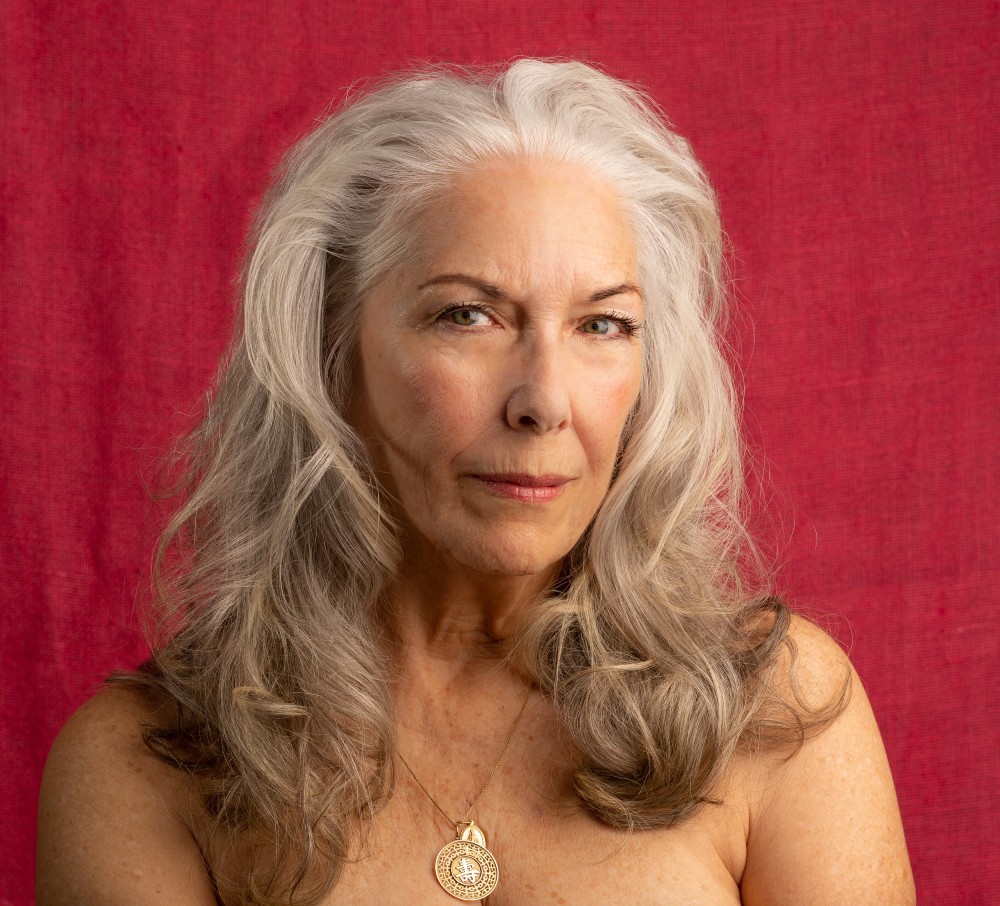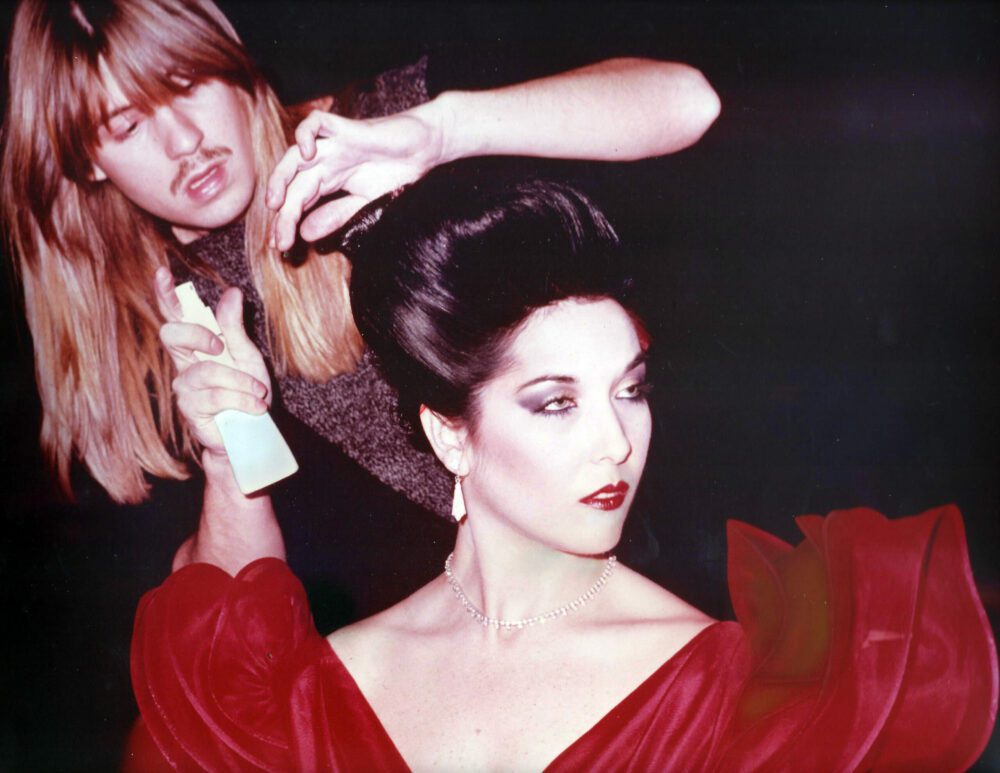

Judith Ann Warren is experiencing the peak of success at the age of 67. In February this year, she posed nude on the digital cover of Vogue Singapore, followed by modelling pastel purple hair in the June edition of Harper’s Bazaar US. The LA-based model/singer/photographer reveals a full-throttle life that careened her from her childhood home in Arizona, to New York City punk clubs to refugee camps in Darfur, finally to land in the City of Angels with newfound recognition as an icon of beauty at any age.
Warren was the first of two girls born into an Irish Catholic family in Chandler, Arizona, to a Navy submariner father and stay-at-home mother. Money was scarce and there was not a great deal of joy at home, and music became a natural escape for a girl who knew she’d inevitably leave Arizona. The 1967 Jefferson Airplane track “White Rabbit” was one of her formative musical memories. “I was 13 and that song was so powerful to me, for some reason,” she remembers. “I didn’t understand it, but I put my own meaning to it.”
Her devout mother forced the kids to attend church every weekend, so Warren joined the church guitar group and began to sing, playing local coffee houses to entertain diners. As a naturally shy child, it was a way of making friends. In high school, she joined the choir. “We weren’t hipsters, we were the odd kids,” she recalls. “I tried out for state choir and made it both years, and as a result of that, I was able to audition for a choir that was going to tour Europe.”
The 250-voice choir (with a 200-piece symphonic orchestra and 50-piece band) flew to New Jersey, stayed on the campus of Princeton University, and held their first concert at Carnegie Hall. “At the age of 16, I was in Carnegie Hall, and it was just such an emotional thing for every kid,” Warren says. “My father flew out to see it, but my mother couldn’t afford it because we had to pay for our own travel expenses. My stepfather and my mum tried to pool what they had, and we did fundraisers.”
The choir’s next stop, in June 1970, was the White House, where they sang for Richard Nixon and Spiro Agnew at the signing of the 26th Amendment giving the right to vote to those aged 18 and up. “To me, it was epic. Carnegie Hall was something you’ll never forget, but we sang ‘The Battle Hymn of The Republic’ and the arrangement was such a powerful, powerful arrangement. It was electric in that room,” Warren says.
From Nixon’s office, the choir headed to London’s Royal Albert Hall. “I’d never been out of the country – I really was an Arizona girl. I was a different human being after that. I was 16 and this was the catalyst for me. I knew I was going on a different journey than my family,” Warren says. “We travelled for a month, then came back to Arizona and in my junior year of high school I left home to save myself. I slept on the sofa of a house with a bunch of college girls and cleaned the house to pay rent. Then, when I was a senior, I rented a house with a friend. All those years, I kept singing.”
As soon as she graduated, Warren moved to California to live with her dad, his second wife and their two sons. “Los Angeles was hard for me,” she admits. “I didn’t know my dad well, and Los Angeles is a hard city to make deep, lasting friendships. I always say to newcomers to this city: don’t be frustrated, you’ll meet your people.”
She ended up working with a “really bad” cover band, Fred Moore & The Best Thing, while trying to break into the music industry. They played various Ramada Inns and Air Force bases. “Fred was a Glen Campbell lookalike who lived with his mother, wore polyester bouffant sleeves, and his mother would make crushed velvet vests and match his shoes to the vest. The keyboard player’s claim to fame was that he’d composed a song for Sonny and Cher. But I loved the guys, unemployed rockstars. Fred was the guy who got the job and paid us all, but I wanted to be like the rock guys,” Warren says.

After a year or so, Warren had a baby. “The father wasn’t a good choice, and he did go on a couple of legs of the tour with us, but he was jealous and had some drug and alcohol problems,” she remembers. “In my infantile world, I thought, having a baby will make us happy. I left the band and I had my son when I was 20. He was brilliant, but I was a baby raising a baby. I kept trying to sing in bands and I always held a job down, but it was hard leaving him to go to rehearsals and sometimes he’d sleep on sofas in studios, like many kids in the music industry.”
Warren had maintained work as a temp for major music executives. “As an assistant I was really fortunate to meet Cavallo Ruffalo & Fargnoli in Santa Monica, who managed Prince, Earth Wind & Fire, and Weather Report,” she says. “I worked in music publishing rights. They had a recording studio and I used to go down on my lunchbreaks and watch Wayne Shorter and the guys from Weather Report or Earth Wind & Fire. I loved it. Prince was this little, wonderful creature who was so shy and so quiet. Jaco Pastorius was brilliant, brilliant, brilliant.”
Through that job, she met Eric Eisner, who was in his 20s at the time. He was legal counsel in-house but was headhunted by David Geffen, beginning work the same week John Lennon was killed. Warren recalls meeting Geffen during a period in which she was being especially experimental with hair and makeup looks. “I was arriving at work with streaks of color or a shaved temple. David Geffen found me in the staff kitchen one morning and said, ‘I don’t get you’, and I said, ‘but you dated Cher!’ It was the best job I ever had.”

She also worked at Island Records, and “met Tom Waits there, which was a dream come true for me,” and recorded vocals for 1995 rave hit “Deus” by Electric Skychurch.
Warren had begun modelling for friends in the downtown scene, including James, her roommate of six years. “He took me from cowboy boots and jeans to something I’d never imagined myself as. I was a dress-up doll for him and his friends – designers, stylists and photographers,” Warren says. “His boyfriend contracted AIDS and died a terrible death, and James discovered later that he had it too. About 20 years ago, he took his life. I lost quite a few friends.”

At 28, she began dating an Englishman who had formed a punk band of three teenage boys called The Invisible Government Of The World, and recruited Warren as the singer. “Those three boys had never played instruments before this band, but they were brilliant. They were commandeered by this Englishman, and I was too,” Warren says. “It was a terrible relationship – he was abusive, and he was a Svengali. It was his ode to politics, and he really wanted to be the star of the show. But we eked out our own space.”
That’s when the former “dress-up doll” got behind the camera; Warren started taking pictures of the band and various shows. As a photographer, she also volunteered with OpUSA, a disaster relief organization, from 2004 until 2008, when she was hired to travel to Darfur with the head of InterAction, which represents most US NGOs. At the time, more than 3 million refugees were displaced and nearly half a million dead in ongoing civil war and genocide at the hands of the Sudanese government.
“We met and spoke with aid workers on their mental health within a conflict zone on what was, at that time, the world’s worst humanitarian crisis,” Warren says. “Darfur was very, very tricky and frightening. I did not have permission to take my camera into the country and you have to have permission, so I was on guard at all times. The airport was surrounded by men with machine guns. We went to Zam Zam camp with 75,000 refugees and I documented that camp and the efforts that international organizations were doing in that camp. It was heartbreaking and life-altering.”
When Warren returned to Los Angeles, she says, “I came back thinking I was going to be in the ranks of all the big photojournalists, but the recession hit. I was the first to be cut loose from the NGO.” She continued to work with non-profits as a photographer, shooting for the American Cancer Society and working with the Taproot Foundation in Louisiana, as well as doing portrait work and dabbling in fashion.

And that brings us to 2019, when Warren’s modelling career 2.0 took seed. “I met a woman via a Facebook page for creatives who was working with Vogue Italia and they were doing a masterclass. The top 10 would be chosen to have their editorial work in the magazine,” Warren explains. “I was partnered with a teenage girl for a theme on the span of ages. They made my hair as straight as an arrow, I had a lot of makeup on, it was the hottest day of the year. We did the shoot and I hid the photos for months. I was so mortified and embarrassed by how old I looked. Two months later the photographer wrote and said, ‘We didn’t win a spot, but I’ve sold the photographs to a magazine.’ One of my solo photos was then chosen to be on the digital platform of Italian Vogue.”
Warren was shocked, but she pulled the photos out and decided to make peace with the way she looked in them. “After that, I got a call from a young woman with the Dragonfly Agency. I walked in and 30 minutes later, walked out with a 3-year contract, and they didn’t even look at my pictures!” she says. “Almost two years later, at the end of 2020, I got the Vogue Singapore job, which came out in February this year. I’ve worked in a couple of commercials, but after Vogue Singapore my life changed in so many ways.”
Overnight, Warren’s Instagram followers went from 75 to over 1,000. She’s being courted by editors and photographers. Not only did the height of her creative career occur beyond 60, but it happened at the height of the pandemic. There’s no clear path to success, if we’re going to find the Hallmark card message here. And there’s no cut-off point at which your skills, passion and curiosity cease to open doors. Warren’s story is a woman’s story, a creative’s story, a musician’s story, and a model story.
Follow Judith Ann Warren on Instagram for ongoing updates.




